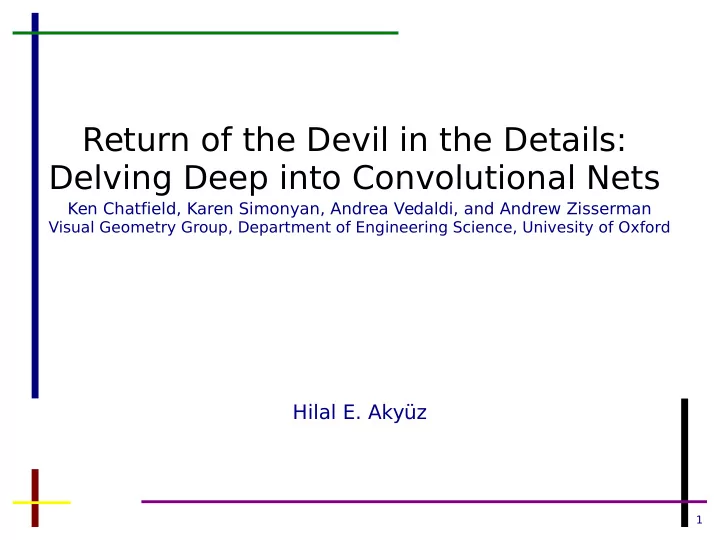

Return of the Devil in the Details: Delving Deep into Convolutional Nets Ken Chatfield, Karen Simonyan, Andrea Vedaldi, and Andrew Zisserman Visual Geometry Group, Department of Engineering Science, Univesity of Oxford Hilal E. Akyüz 1
2 slide by Chatfeld et al
3 slide by Chatfeld et al
What is Changed Since 2011? ● Different deep architectures ● The latest generation of CNNs have achieved impressive results ● Unclear how the different methods introduced recently compare to each other and to shallow methods 4
Overview of the Paper This paper compare the latest (till 2014) methods ● on a commond ground . Several properties of CNN-based representation ● and data augmentation techniques Compare both different pre-trained network ● architectures and different learning heuristics . 5
Dataset (pre-training) ● ILSVRC-2012 – Contains 1,000 object categories from ImageNet – ~1.2M training images – 50,000 validation images – 100,000 test images ● Performance is evaluated using top-5 classification error 6
Datasets (training, fine-tuning) ● Pascal VOC 2012 ● Pascal VOC 2007 – Multi-label dataset – Multi-label dataset – Contains ~ twice as – Contains ~10,000 images many images – 20 objects classes – Does not include test set, instead, evaluation uses the – Images split into train, official PASCAL validation and test sets. Evaluation Server. ● Performance is measured as mean Average Precision ( mAP ) 7
Datasets (training, fine-tuning) ● Caltech-101 ● Caltech-256 – 101 classes – 256 classes – Three random split – Two random split – 30 training, 30 testing – 60 training, the rest are images per class . used for testing ● Performance is measured using mean class accuracy 8
Outline ● 3 scenarios: – Shallow represantation – Deep representation (CNN) with pre-training – Deep representation (CNN) with pre-training and fine-tuning ● Different pre-trained networks – CNN-S, CNN-M, CNN-F Scenario-specifc Reducing CNN final layer output dimensionality ● best practices Data augmentation ( for both CNN and IFV ) ● Generally-applicable Color information best practices ● Feature normalisation (for both CNN and IFV) ● 9
1 0 Data Augmentation slide by Chatfeld et al
1 1 slide by Chatfeld et al
Scenario1: Shallow Representation (IFV) IFV usually outperformed related encoding ● methods Power normalization for improved ● 1 2
IFV Details Multi-scale dense sampling ● SIFT features ● Soft quantized using GMM with K=256 components ● Spatial Pyramid (1x1, 3x1, 2x2) ● 3 modification: ● – Intra-norm ● L2 norm is >applied to the subblocks – Spatially-extended local descriptors ● Memory-efficient than SPM – Color features ● Local Color Statistics 1 3
Scenario2: Deep Representation (CNN) with Pre-training ● Pre-trained on ImageNet ● 3 different pre-trained networks 1 4
1 5 slide by Chatfeld et al
1 6 Pre-Trained Networks slide by Chatfeld et al
Scenario3: Deep Representation (CNN) with Pre-training & Fine-tuning Pre-trained on one dataset and applied to another ● Improve the performance ● Become dataset-specific ● 1 7
CNN Details ● Trained with same training protocol, same implementation ● Caffe framework ● L2 normalization of CNN features – Before introducing to SVM 1 8
CNN Training ● Gradient descent with momentum – Momentum is 0.9 – Weight decay is 5x10 -4 – Learning rate is 10 -2 , decreased by 10 ● Data augmentation – Random crops – Flips – RGB jitterring ● 3 weeks with a Titan Black (Slow arch.) 1 9
CNN Fine-tuning ● Only last layer ● Classification hinge loss (CNN-S TUNE-CLS), ranking hinge loss (CNN-S TUNE-RNK) for VOC ● Softmax regression loss for Caltech-101 ● Lower initial learning rate (VOC & Caltech) 2 0
2 1 slide by Chatfeld et al
Analysis 2 2
2 3 slide by Chatfeld et al
2 4 slide by Chatfeld et al
2 5 slide by Chatfeld et al
2 6 slide by Chatfeld et al
2 7 slide by Chatfeld et al
2 8 slide by Chatfeld et al
2 9 VOC 2007 Results slide by Chatfeld et al
3 0 slide by Chatfeld et al
3 1 slide by Chatfeld et al
Take Home Messages Data augmentation helps a lot, both for deep and ● shallow methods Fine-tuning makes a difference, and use of ranking ● loss can be prefferred Smaller filters and deeper networks help, although feature ● computation is slower CNN-based methods >> shallow methods ● We can transfer tricks from deep features to shallow ● features We can achieve incredibly low dimensional (~128D) but ● performant features with CNN-based methods ● If you get the details right, it's possible to get to state-of-the-art with very simple methods!! 3 2
3 3 slide by Chatfeld et al
Thank You For Listening.. Q&A? (DEMO) Hilal E. Akyüz 3 4
DEMO CNN Model Pascal VOC 2007 mAP CNN-S 76.10 CNN-M 76.11 AlexNet 71.40 GoogleNet 80.91 ResNet 83.06 VGG19 81.01 3 5
Demo Model FPS (batch size=1) CNN_M 169 CNN_S 151 ResNet 11 GoogleNet 71 VGG19 50 3 6
3 7 Extras slide by Chatfeld et al
3 8 Extras slide by Chatfeld et al
3 9 Extras slide by Chatfeld et al
Recommend
More recommend